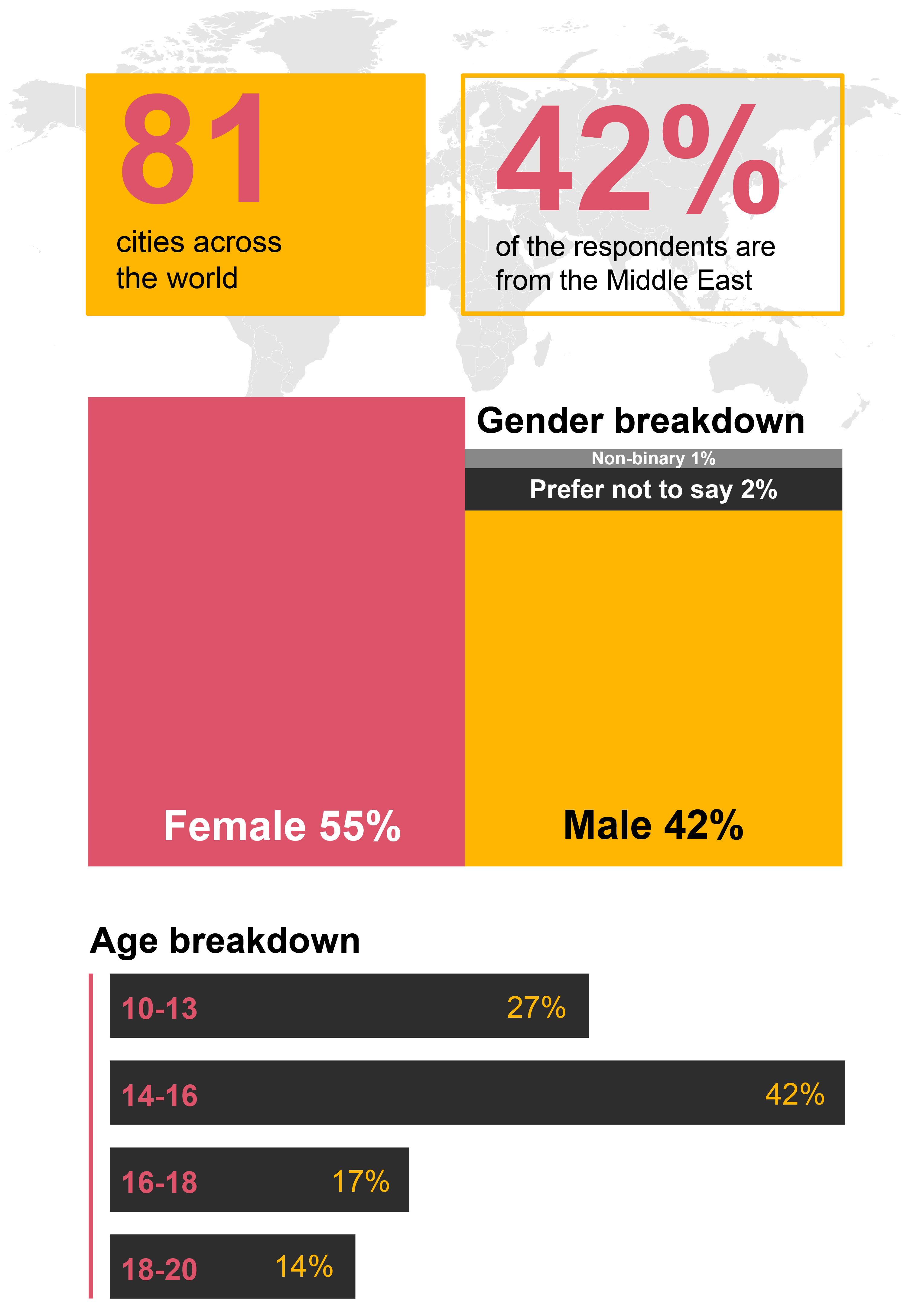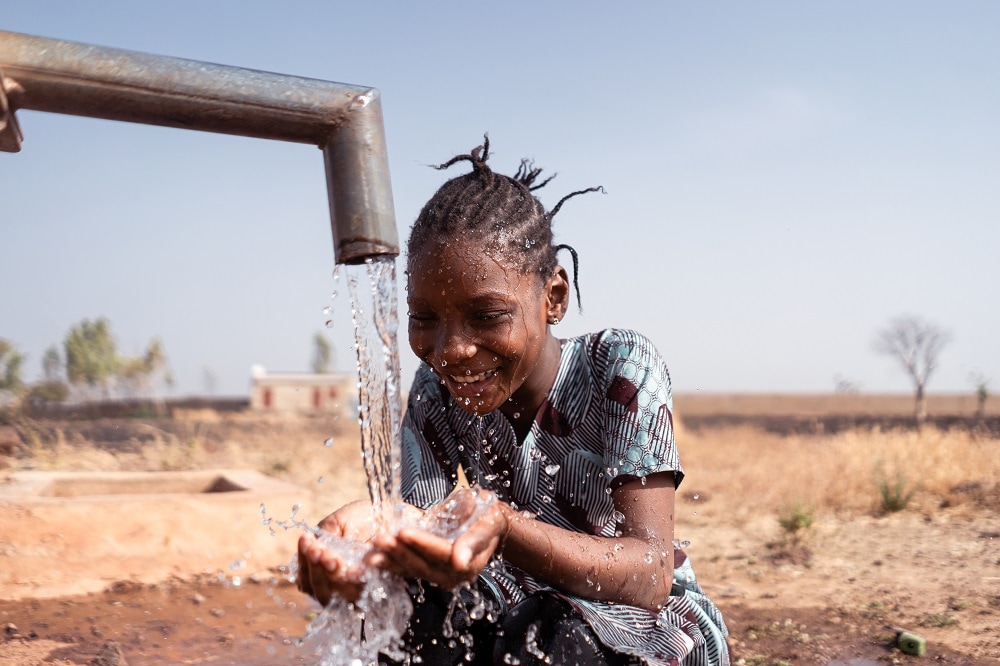Leave no-one behind
Our world is changing; adapting and evolving to disruption and natural disturbances in its physical environment combined with the shifting priorities and aspirations of its people. Over the past decade, the international community has come together to collaborate and address the mounting scientific evidence that if things continue as they are, planet Earth will not survive. The onus is now on us to seize the opportunity of our collective awareness and work towards preserving our planet and its people’s wellbeing.
This report voices the views, ambitions, and engagement of approximately 700 children and young adults between the ages of 10 to 20 from 81 cities across the world with the Sustainable Development Goals (SDGs). It reflects the findings of a survey that captures their perspectives on the Goals, their vision for the future, and how they are working to support their achievement. In so doing, it is a call for action to further engage youth as architects and co-creators of a fairer, more sustainable tomorrow.
In 2015, all 153 United Nations member states adopted the 2030 Agenda for Sustainable Development. The Agenda sets a blueprint for developed and developing countries to work together to achieve 17 Sustainable Development Goals (SDGs). The Goals aim to mitigate and eliminate these socio-environmental risks and have since become a global hallmark for sustainable, holistic development. Though both ambitious and universal, the SDGs have long been criticised for being off-track and non-binding. They were also thrown off-course by the COVID-19 pandemic that reversed the progress made over the past 15 years and magnified pre-pandemic inequalities at both the national and international levels. As a result, socially vulnerable groups and developing countries have been the hardest hit by the pandemic and are now the farthest away from achieving the SDG targets. So much so that a 2020 United Nations Report on the Sustainable Development Goals found that the pandemic had negatively impacted each of the 17 goals and the achievement of their targets.
Even though today’s youth population is the largest in history, representing 16% of the global population and 1.8 billion people1; youth awareness and engagement around the SDGs has been, for the most part, overlooked. This is particularly concerning given the fact that youth numbers are projected to grow over the coming years: the number of children turning 15 between 2015 and 2030 will reach 1.9 billion and will continue to rise.
This is a modal window.

An “unfair” pandemic
The 2020 United Nations Report on the Sustainable Development Goals quantifies the setbacks the COVID-19 pandemic has made to the SDGs against a backdrop of accelerating environmental degradation as follows:
Approximately 71 million people pushed back to extreme poverty
Disruption and limited access to schools, health care facilities and nutrition have resulted in a surge in domestic violence against women and children, placed greater pressure on women, and increased the risk of under-5 and maternal deaths. It has also resulted in a rise in child labour/trafficking that pushes back gains made over the past 20 years
A rise in underemployment and unemployment, especially amongst the 1.6 billion vulnerable workers in the informal sector pushing a 60% decrease in income
Deterioration in infrastructure and living conditions of the one billion plus people living in urban slums
Big bets on multilateralism, government and activism… but where is business and individual action?
In early 2021, Edelman produced its annual Trust Barometer, highlighting a spiralling downturn in trust in government and a rising expectation that business will lead, and indeed, should further step up to fill the void of societal problems. The youth views expressed in our survey paint a different story. Non-governmental and international organisations (NGO and IO) lead in terms of “doing enough” to support our planet and people (49%) and are closely followed by government, (37%). At the other end of the spectrum, our respondents believe that business is the group doing the least to help the planet, closely followed by individuals.
Strikingly, a disproportionate number of the respondents were unsure how to answer the question of whether enough is being done. Across the board, except for government (20%), almost 40% of the survey participants did not know whether the group in question was doing enough. This may indicate a gap in youth outreach and communication and raises the question of whether certain groups could be doing more to promote their involvement with the SDGs.
The young “people’s goals”
Our survey shows a high level of awareness among our youth respondents around the SDGs. This is particularly refreshing since the youngest age bracket covered in the survey began at 10 and carried through to 20 years of age, with most of the respondents (42%) between the ages of 14 – 16 years of age.
The significance of this level of awareness extends beyond the obvious fact that it is these very same youth that will live the consequences of our actions towards our planet, how we treat it, and the sustainability of its resources in the future.
Rather, a high level of awareness of the SDGs reflects a willingness and desire to better understand and possibly engage, beyond borders and boundaries, and embrace the idea of a collective future both impacting and impacted by others.
Prioritising clean water & sanitation, climate action and zero hunger
Given the high level of SDG awareness among the survey respondents, it is important to understand the significance of these goals and what they mean to them.
In this respect, 73% of the survey respondents believe SDG 6: Clean Water & Sanitation, is "extremely important" and is hands down the Goal which is the most important to the survey participants. In addition to the emphasis that the pandemic has made on the importance of good hygiene for the management and prevention of disease; water has an important bearing on livability, livelihoods, economic productivity, and biodiversity. Today, 2.2 billion people – one in three of the world’s population lack access to safe drinking water, and over 673 million people do not have any sanitation facilities.
With the ongoing changes spurred by climate change, action is needed to better manage wastewater (80% of which flows back into the ecosystem without being treated), safeguard the world’s remaining wetlands (70% of which have been lost), and explore new innovations in water generation and management2.

Closely following SDG 6, were “SDG 13: Climate Action” (72% ‘extremely important’) and “SDG 2: Zero Hunger” (69% ‘extremely important’).
The devastating impact of climate change and the imperative to reach the 1.5 degrees Celsius mark needed to save humanity is sadly already felt by many across the world. In the hot Summer of 2022, the United Kingdom saw record temperatures reaching 40 degrees Celsius for the first time in their weather recording history3. Beyond the increase in temperature, and the consequent rise in wildfires, heat-related illnesses and general limitations on mobility and productivity; climate change also has a strong impact on a variety of other key factors as well. These include but are not limited to severe storms that result in flooding and landslides, drought and water scarcity, rising sea levels and the elimination of islands and coastal cities, as well as the loss of species, destruction of crops and consequently food insecurity, poverty, and hunger.
As previously highlighted, drastic changes are needed if we, collectively, are to meet our “Zero Hunger” goal by 2030.
Indeed, as the official wording of the Goal is to “end hunger, achieve food security and improved nutrition and promote sustainable agriculture", almost all aspects of this goal are particularly challenging. Current estimates by the United Nations indicate that in the present time, approximately 690 million people are hungry – representing 8.9% of the world population. This figure, which increased by 10 million people in one year, is projected to surpass 840 million by 2030 if current trends are not reversed4. And while all 17 of the SDGs are interlinked and interdependent, it is perhaps “Zero Hunger” that is most affected by progress on the other goals, ranging from peace and security, to gender equality, access to water and climate change.
Given that the Middle East represents the largest region of respondents to the survey (44%), it is important to point out that these three goals represent key priorities for the region moving forward. 9 of the world’s 10 most water poor countries are Middle Eastern, and if it is to continue to warm at double the global average, by 2030 it will be 4 degrees warmer than the 1.5-degree threshold needed to save humanity.
Conflict and the fragility of many of the nation states in the Middle East has meant that over the past two decades – as estimated by the World Food Organisation - the Arab world experienced a 91% increase in undernourishment. Currently, 15.8% of the Arab population are under-nourished, which is considerably higher than the global average of 9.9%5.
Committed but not sure where or how to go…
Our survey shows a global youth community that is committed to actively shaping its future. Across all 17 Goals, most young people are either already engaged, planning to engage, or would like to engage around the SDGs. That said, approximately one third of the respondents are unsure how to actively support the Goals.
Naturally, some SDGs have a higher level of youth participation and contribution than others. SDG 5: Gender Equality, and SDG13: Climate Action have the highest levels of ongoing youth engagement.
Not only is gender equality a fundamental human right, but it is also an important requisite for a prosperous, thriving society. Raising awareness and engaging youth around the societal norms and social constructs that underpin gender discrimination and injustice is key to addressing one of the most pressing issues of our time. According to the World Economic Forum’s 2021 Gender Parity Index, which measures accessibility and equality across a wide range of indicators, the world is only 68% on the way to achieving gender parity - 0.5 percentage points back from 2020. This small percentage change has increased the trajectory of years needed to close the gender gap from 99.5 years in 2020 to 135.6 years6. Disturbingly, in addition to the non-material gender restrictions and the glass ceiling alluded to above, significant legal and regulatory barriers to gender equality continue to exist to this day across the world. Despite significant regulatory changes over the past couple of years, the global average of the World Bank’s “Women, Business and Law Score” is 76.5/100, meaning that globally, billions of women still do not have the same legal rights as men – on average, the typical woman enjoys three quarters of the legal rights granted to men7.
The level of engagement of youth around SDG 13: Climate Action is not surprising, given the importance the United Nations and its various bodies, the Conference of the Parties and other international and regional organisations place on youth engagement around climate change.
Typically, youth engagement around climate change takes place through a variety of channels, including but not limited to conferences, community-organised events, exchange programmes etc. Moving forward and building on this momentum, in the future, youth voices should be better represented and heard at international fora where decisions are taken and made (Greta Thunberg's speech at the U.N. Climate Action Summit in 2019 comes to mind). Institutional safeguards should also be put in place to ensure that this representation is diverse, inclusive and fully representative of youth, and that communication channels are not limited to a privileged few.
Recommendations and key takeaways
The vast majority of reports that explore the SDGs tend to paint a grim picture of what the future looks like. Climate change, social injustice and economic inequalities have dominated the international development agenda, amplified by the disproportionate impact of the COVID-19 pandemic on developing economies and vulnerable social groups. Our survey shows despite the urgency and pressing need of addressing these issues, there is strong potential to garner youth optimism and energy to engage around building a better tomorrow.
Key takeaways

Youth are keen to actively engage around the SDGs and better their societies. Focused youth-outreach programmes are needed to raise awareness of how different groups contribute to society.

A considerable number of young people are actively supporting communities achieve targets in the SDGs that matter the most to them. Celebrating these contributions and their impact will inspire innovations as to how youth can effectively contribute to the SDGs.

Concerted efforts need to be made to address information and communication gaps in SDGs that have been highlighted as priorities by youth, but which there is lack of clarity as to how they can structure their engagement/ contribution towards their realisation.
1) United Nations; The Sustainable Development Goals: Youth & SDGs; https://www.un.org/sustainabledevelopment/youth
2) United Nations Department for Economic and Social Development, “Water & Sanitation”, https://sdgs.un.org/topics/water-and-sanitation and United Nations Sustainable Development Goals, “Goal 6: Ensure Access to Safe Water and Sanitation for All”, https://www.un.org/sustainabledevelopment/water-and-sanitation/
3) https://www.bloomberg.com/news/articles/2022-07-19/weather-heatwave-latest-l5s4h86d
4) United Nations Sustainable Development Goals, “Zero Hunger”,
5) Food & Agriculture Organization of the United Nations, “Near East and North Africa Regional Overview of Food Security & Nutrition: Statistics & Trends 2021.
6) World Economic Forum, “7 of the Most Surprising Facts About Global Gender Gaps”, March 31, 2020, https://www.weforum.org/agenda/2021/03/global- gender-gap-facts/
7) World Bank Group, “Women, Business and the Law”










